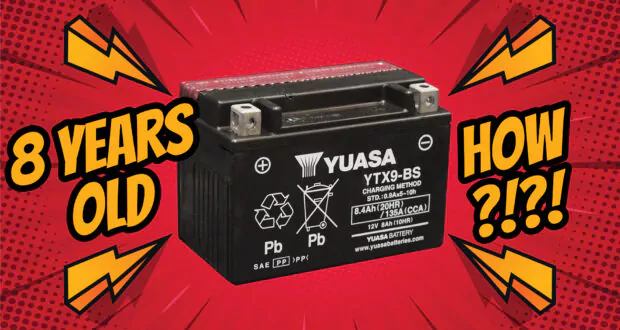There are seven things that determine your motorcycle battery’s lifespan. Four of them are up to you and totally within your control. The other three have to do with manufacturers, so you’ll want to make sure you know what they are before you ever buy another motorcycle battery.
I’m Adrian from YouMotorcycle, I make videos for people who want to learn more about motorcycling. I’ve had to deal with weak motorcycle batteries in the past, and it sucks! If you’re home it’s not as bad, but if you’re out you have the added cost of a tow truck, and that can get expensive.
Today we’re going to talk about why your riding habits might be killing your battery, why the initial battery setup and charge is critical, what good maintenance and storage looks like, and why your battery’s capacity, type, and especially the manufacturer you choose matters.


1) How the battery was setup
Let’s start at the very beginning, a brand new motorcycle battery. This may or may not be in your control depending on if you set up your motorcycle battery when it was new, or someone else did. Either way, setting up a new motorcycle battery the right way will impact not only your battery’s longevity, but it’s overall power and performance too.
I have a whole video on how to fill, charge, and replace a motorcycle battery the right way. Long story short, if you don’t wait for the acid to stop bubbling, and if you charge your battery the wrong way that first charge, your motorcycle battery is never going to last as long or crank as strong, so I’ll link to that video at the end of this one and I suggest you check it out.
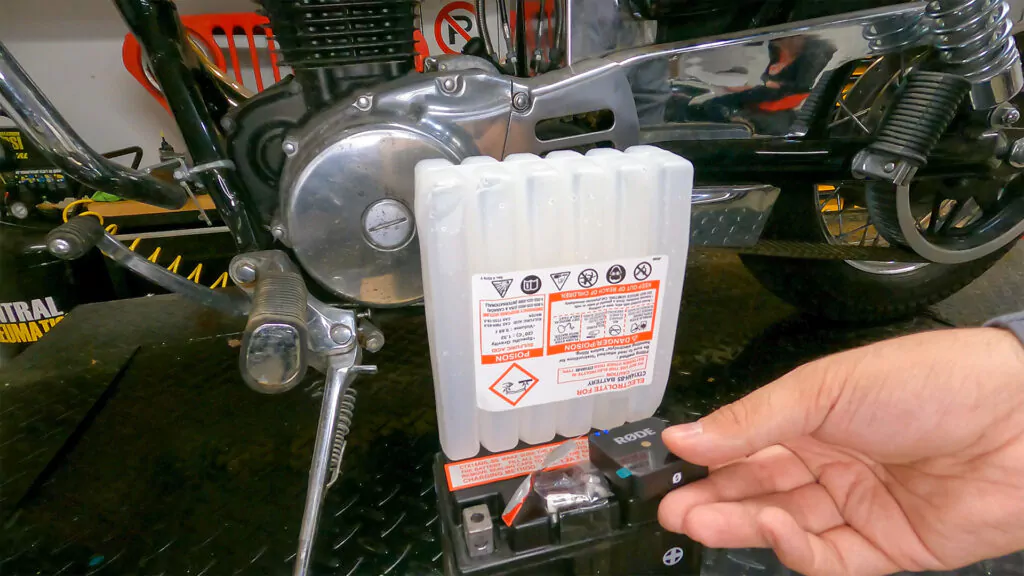
Filling a motorcycle battery with acid. The mic is recording the sounds of the acid bubbling.
2) How the battery is used
Next up, and this is totally within your control: how your battery is used will definitely impact its longevity. Did you know that shorter motorcycle rides, as well as frequent riding in stop and go or slow moving traffic can decrease your motorcycle battery’s lifespan?
Does that mean you should avoid taking your motorcycle to work or on short errands? No, of course not. But if we understand why that is, we can understand a lot about how our batteries work and what their weaknesses are.
The key thing to understand is that motorcycle batteries run on a sort of give and take system, with the rest of your motorcycle.
Going on shorter rides means the battery is being asked to turn the starter motor over more often, which isn’t an easy task. You’re taking a lot out of your battery, and without a long ride you might not be giving it enough back.
A motorcycle needs high RPMs to recharge your battery. It isn’t like a car that can really recharge just sitting at idle. That’s why sitting in stop and go rush hour traffic on your commute home can also be harder on your battery. It’s doing it’s job, but it isn’t necessarily getting a lot back from your motorcycle without that high RPM riding that it needs.
There are other little things riders do sometimes, like turning on their headlights, then putting on their gear, and then starting the bike. Leaving the battery doing all the work without the motor running isn’t good for it, neither is killing your motorcycle with your kill switch and then taking your gear off before you turn your key to the OFF position.
Basically the thing to remember is that our batteries work on give and take. It’s important to make sure that we aren’t just taking power out of the battery, but that we also do a good job of putting power back into it in order to maximize battery lifespan.
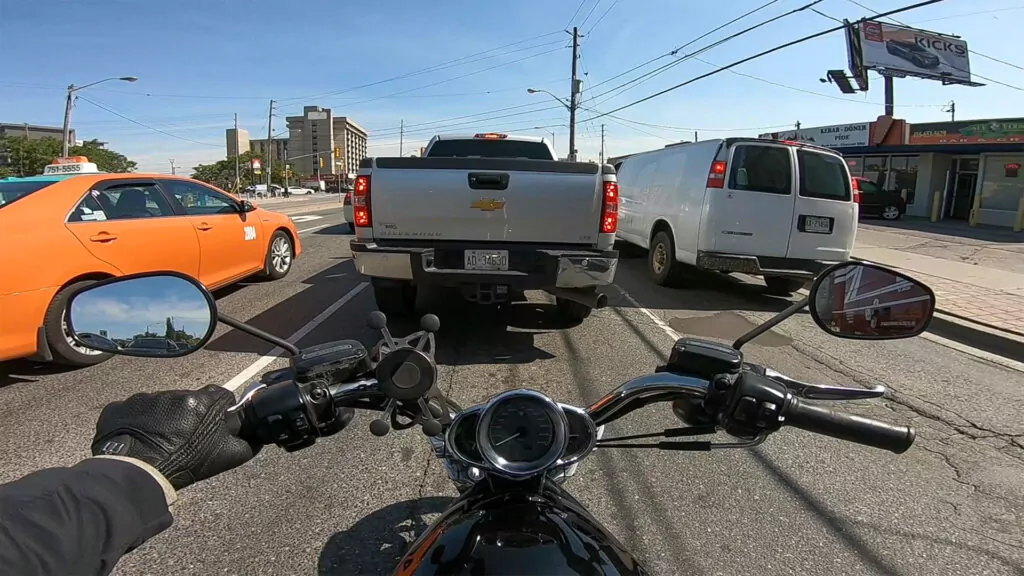
My Night Rod stuck in bumper-to-bumper rush hour traffic.
3) The quality of the battery
The quality of your battery is out of your control, unless you’re buying a new battery.
When it comes to lead acid batteries, Yuasa is the only brand I recommend. I have no affiliation with these guys but I’ve been recommending them since all the old mechanics told me I could count on them when I first started working in the motorcycle industry 12 years ago.
If you wanted to try out a lithium battery, I’d recommend paying a little more for Antigravity. Buying from a reputable name brand like these can mean your motorcycle battery will last longer.
Companies like Yuasa and Antigravity are known to use high quality chemicals and materials in their manufacturing. They maintain a high standard in both manufacturing and quality control standards and they have built a reputation for quality over years and in Yuasa’s case, decades.
You’ll find all kinds of fly by night cheap battery companies on Amazon and eBay, and they often value profits over reputation, they use cheaper quality lead or lithium, they have less stringent manufacturing processes or standards. When things go wrong there’s no phone number to call, no employees to be found, no office you can show up to. You’re buying from a company that won’t support you if things do go wrong.
4) How the battery is stored
The way a motorcycle battery is stored is up to you, and it can greatly impact the battery’s lifespan. Lead acid batteries don’t like extreme temperatures, and it’s not just the cold you need to worry about! Excessive heat can cause the battery to degrade more quickly too.
We’ll talk about proper battery maintenance in a second because that’s really important but I just want to give you guys a little personal anecdote.
I have a Yuasa battery that’s about eight years old that an ex girlfriend got me for a birthday or something. In the eight years since she told me I was the love of her life and she bought me this battery, we’ve broken up, she’s met the next guy she called the love of her life, they broke up, then she met the next love of her life, they got engaged, they had a baby, and now her and the kid are that guy’s problem, and me and my bike and that battery are still here firing up the first time every time.
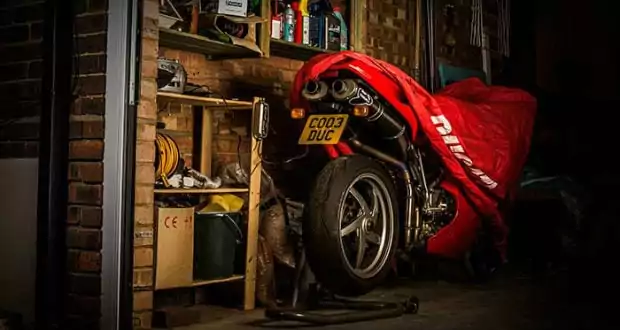
Motorcycle parked away for storage.
5) Battery capacity
Larger capacity motorcycle batteries tend to be a bit more hardy than smaller ones. A friend of mine says it feels like she replaces her Vespa battery every year compared to her motorcycle battery, and she has a point.
Smaller motorcycles and scooters tend to use smaller batteries for a combination of cost, weight, or space-saving. But a larger battery has more energy stored in them.
It’s like a small well versus a larger one: The larger the well, the more buckets of water you can take out of it before coming up dry. And in general, a battery that is consistently only a little discharged, will outlast a battery that is much more discharged because it has a smaller capacity.
Larger capacity batteries can also handle deeper discharge cycles better, meaning they can be discharged to a lower state of charge and still retain their capacity over time.
Finally, larger batteries typically have more “reserve capacity”, so they can supply power for a longer period of time, before the voltage drops too low to be useful, compared to smaller batteries.
6) How well the battery is maintained
Another thing totally within your control is how well the battery is maintained. Proper battery maintenance is one of the biggest factors in battery lifespan. Unfortunately, battery maintenance also gets neglected by motorcyclists quite often.
Did you ever notice that your motorcycle battery terminals always have plastic covers over them? That’s because dirt and grime building up on the terminals of the battery can create resistance which can shorten your battery’s lifespan. But that’s not all.
Proper maintenance of lead-acid batteries means keeping the batteries charged up. Allowing a battery to be discharged too deeply, or leaving it in a discharged state for an extended period of time can shorten the battery’s lifespan as the lead plates inside the battery become sulfated. This damage can be irreversible and accumulates over time.
Just like undercharging or neglecting a battery can hurt it’s lifespan, so can overcharging a battery. Motorcycle batteries typically don’t like being charged over 1 Ah. A common problem is that people will plug them into car chargers, which charge at 5 Ah rate, which ends up cooking the battery. It’s important to buy a motorcycle-specific battery charger for your battery. Likewise, if you buy a lithium battery, it’s important to buy a lithium-specific battery charger.
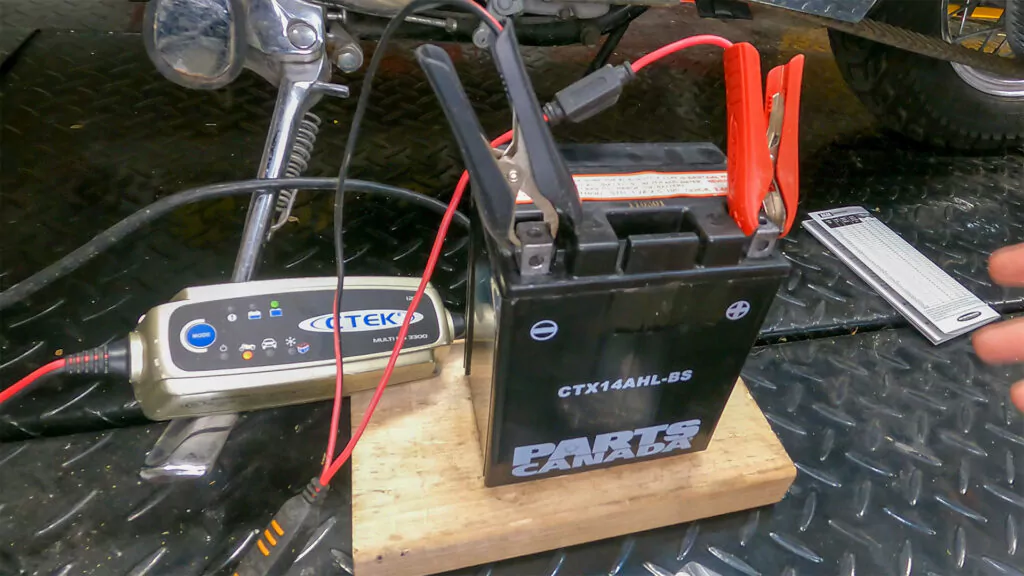
Motorcycle battery charging
7) The type of battery
Most motorcycles come from the factory with lead acid batteries, but lithium motorcycle batteries will actually last longer for three key reasons.
Lithium motorcycles batteries have a higher energy density, meaning they can store more energy in a smaller space. We’ve already talked about what having more energy in your battery can do for you.
Lithium batteries also have a lower self-discharge rate, so they lose less of that energy over time when the battery is not in use.
Finally, lithium motorcycle batteries have a higher cycle life, meaning they can be charged and discharged more times before reaching the end of their lifespan then a lead acid can.
So you might not have control over what your battery your motorcycle comes with, but you can always choose to upgrade later.
Conclusions
I currently have a ton of content on motorcycle batteries including step by step instructions on two easy ways to load test your motorcycle battery and your charging system to see what kind of health your battery is in, and if you find you need to replace your battery. I also have a video on how to properly set up a brand new battery to maximize its performance and longevity.
Now I’d love to hear from you. If this video was helpful please hit the thumbs up button or leave me a comment and let me know what battery brand you’ve tried and what your experience was like. I’d love to hear what you have to say.
Thanks for watching, ride safe, but have fun.
What to do if you have a dead battery
1) Get yourself home if you can
If you’re reading this from the side of the road, good news, you can ask a by-stander with jumper cables to help you out.
Remember that cars need (and produce) much more voltage than our motorcycles are designed to handle. Hooking up to a running car can damage your motorcycle! Before you do anything, make sure to keep the car turned off.
All you’ll need to do is connect the red jumper cables to the positive battery terminals of both vehicles, and the black jumper cables to the negative battery terminal. Then with the car still turned off, try to start the motorcycle. You can check out my full details on how to jumpstart your motorcycle, or in the video above.
2) Recharge it and test it
If you find yourself with a dead motorcycle battery, the first thing to do is grab your motorcycle-specific battery charger and recharge your battery. Remember not to use a car battery charger!
Once your battery is recharged, you’ll want to test your motorcycle battery to determine if it needs to be replaced, or if you can get away with simply recharging it.
Remember: Just because your battery could take a charge and start your motorcycle up again, doesn’t mean it won’t leave you stranded later on down the road. Sometimes you don’t need to spend over $100 on a new motorcycle battery, but sometimes you do. I recommend watching the video above, and checking on my article on how to tell if you need to replace (or just recharge) your motorcycle battery.
3) Replace it if you need to
If you find you need to replace your motorcycle battery, you don’t have to bring it to a shop. It’s easy to fill, charge, and replace a new motorcycle. You can check out the link to my how-to article, or watch the video below:
 YouMotorcycle Motorcycle Blog – Motorcycle Lifestyle Blog, MotoVlog, Motorcycle Reviews, News, & How-Tos
YouMotorcycle Motorcycle Blog – Motorcycle Lifestyle Blog, MotoVlog, Motorcycle Reviews, News, & How-Tos
